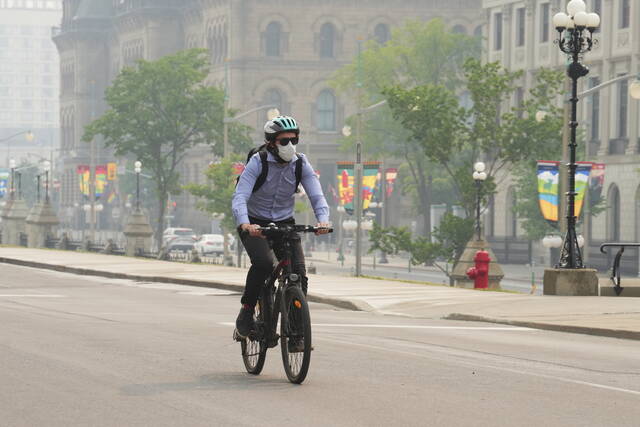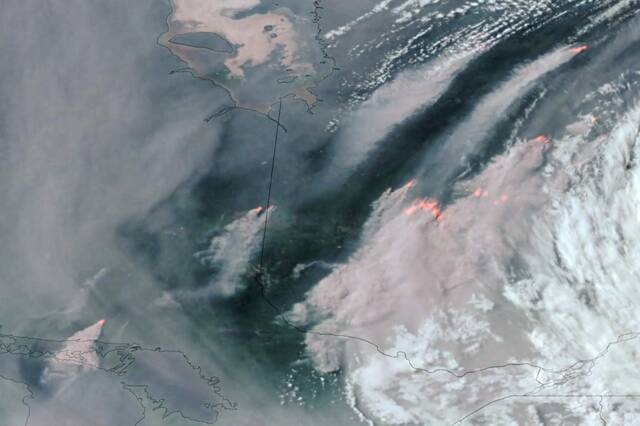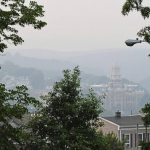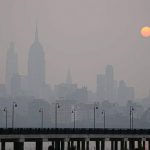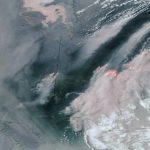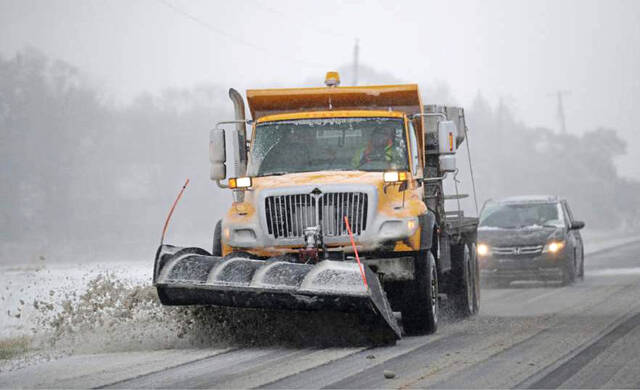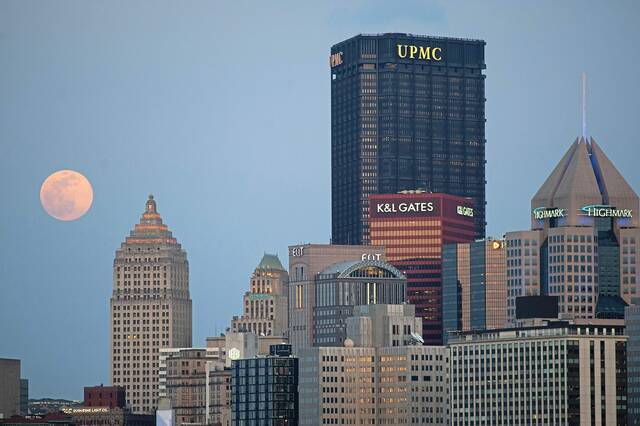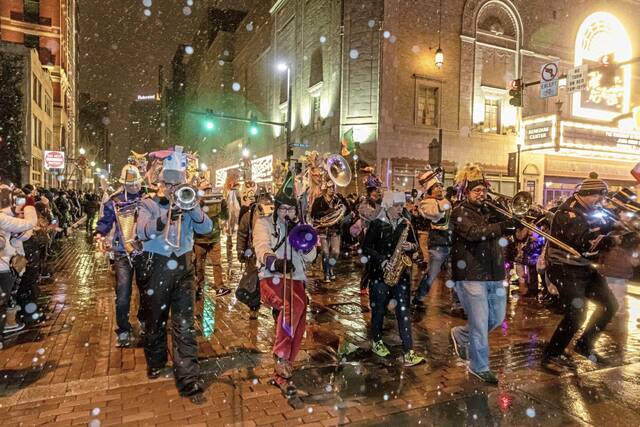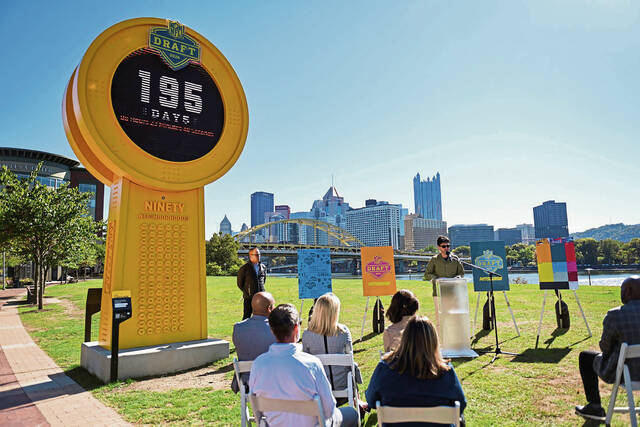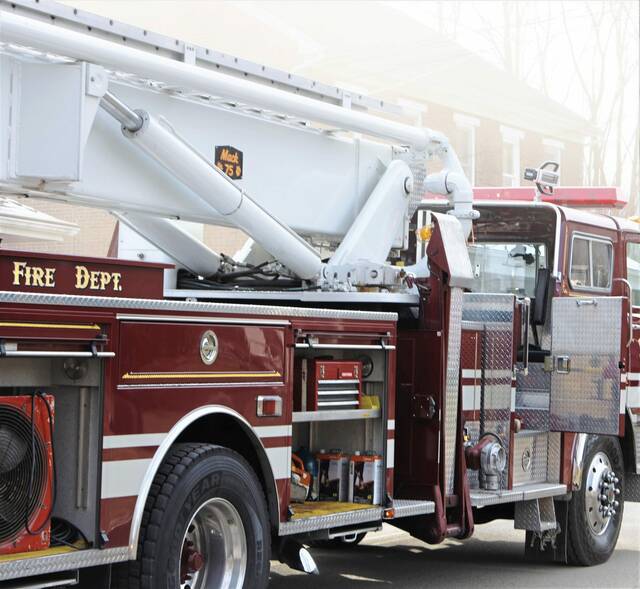Air quality in Western Pennsylvania dropped to unhealthy levels Wednesday and could remain that way until at least Sunday as smoke from Canadian wildfires continues to pollute the Northeast.
Pittsburgh’s air quality index, or AQI, hit 155 around 3 p.m., according to the government website AirNow.gov. The reading had dropped to 131 by 5 p.m.
Air quality is considered unhealthy for all people when readings are 150 or above.
Readings of between 100 and 150 are considered unhealthy for sensitive groups, including people with asthma, emphysema and chronic obstructive pulmonary disease (COPD). AirNow.gov predicted that Pittsburgh’s AQI would reach 130 on Thursday and 100 on Friday.
The Pittsburgh region was forecast to see code orange Thursday.
The Pennsylvania Department of Health has warned that the poor air quality can particularly impact people with heart disease, people with lung disease, older adults, children and teens, people who are pregnant and people who work outdoors. Health officials have urged everyone to avoid strenuous outdoor activities and to keep outdoor activities brief.
Air conditions might not improve until Sunday or later, said Lee Hendricks, a meteorologist in the National Weather Service’s office in Moon Township.
He said the Pittsburgh region is between a low-pressure area near New England and a high-pressure area to the west, and that is exacerbating the counterclockwise, north-to-south winds in our region. Those north-to-south winds are responsible for bringing smoke from Canada down into the Mid-Atlantic and Northeast regions.
The National Weather Service is forecasting about a half-inch to an inch of rain in Pittsburgh through Sunday.
“It’s not a great deal of rain, but it would help with air-quality issues,” Hendricks said.
Elsewhere in the Northeast, the air-quality index in New York City measured at 413 as of 5 p.m. Wednesday, compared with 255 in Philadelphia, 218 in State College, Pa., and 168 in Washington, D.C.
Pennsylvania’s Department of Environmental Protection declared a “code red” for the entire state Wednesday because of smoky, hazy conditions.
The DEP said people should reduce long or intense outdoor activities and take more breaks during outdoor activities. People in sensitive groups should avoid long or intense outdoor activities.
People in sensitive groups have more difficulty processing air filled with more particulate matter, which are mixes of solids and liquids too small to be seen that contain hundreds of chemicals.
“Our instruction is to stay inside,” said Dr. Tariq Cheema, director of Allegheny Health Network’s Breathing Disorder Center. “When vulnerable people don’t follow that advice, they really get into trouble.”
AHN and UPMC did not see an increase in breathing-related visits to their emergency rooms Wednesday, but Cheema said AHN doctors have been inundated with phone calls from concerned patients.
In his 20 years as a pulmonologist, Cheema said he has never seen this unique combination of wildfires and weather conditions causing air-quality issues. The closest comparison may be found in California, which has struggled with its own bouts of wildfires in recent years, he said.
“This is something you can actually see,” Cheema said. “There’s smoke in the atmosphere. We don’t know what it’s going to do. But it’s not good.”
Conditions this week also triggered a warning in which companies “most significantly contributing to particulate pollution in the Mon Valley region” are ordered to temporarily reduce emissions, the Allegheny County Health Department said.
(1/2) When was the last time we saw smoke like this in Pennsylvania? Well, July 2002 we were under a similar pattern and fires were ongoing in Quebec. Here is a @NASA image from July 7, 2002. pic.twitter.com/26NqtvUdpf
— NWS Pittsburgh (@NWSPittsburgh) June 7, 2023
Unlike wildfires where the smoke is primarily present well above the ground, resulting in hazy skies, this smoke episode also has been at the ground level, resulting in poor air quality, low visibility and serious health risks to people, especially those outdoors, according to AccuWeather.
“Some air quality observation sites (appear) to report their highest concentration of harmful particulate pollution in the air since 1999,” the weather agency said in a statement. “AccuWeather estimates that breathing the polluted air in the worst impacted areas of the Northeast for several hours can result in breathing in the same level of harmful air as smoking five to 10 cigarettes.”
Related:
• Photos: Northeastern cities experiencing smoky skies because of Canadian wildfiresMeanwhile, environmental advocates decried climate change, which they say triggered the dry conditions fueling the wildfires in Quebec and Ontario.
The Breathe Project, which is based in Pittsburgh, said climate change continues to impact air quality and industry in Allegheny County, as well as the day-to-day routines of Americans’ lives.
“We call upon policymakers and leaders to take note so that they can take action to reduce our dependencies on climate-disrupting fossil fuels to pursue policies that center on health and climate, and to recognize these sorts of disruptions will only end when we start working together for a healthier future,” said Matt Mehalik, the group’s executive director.



